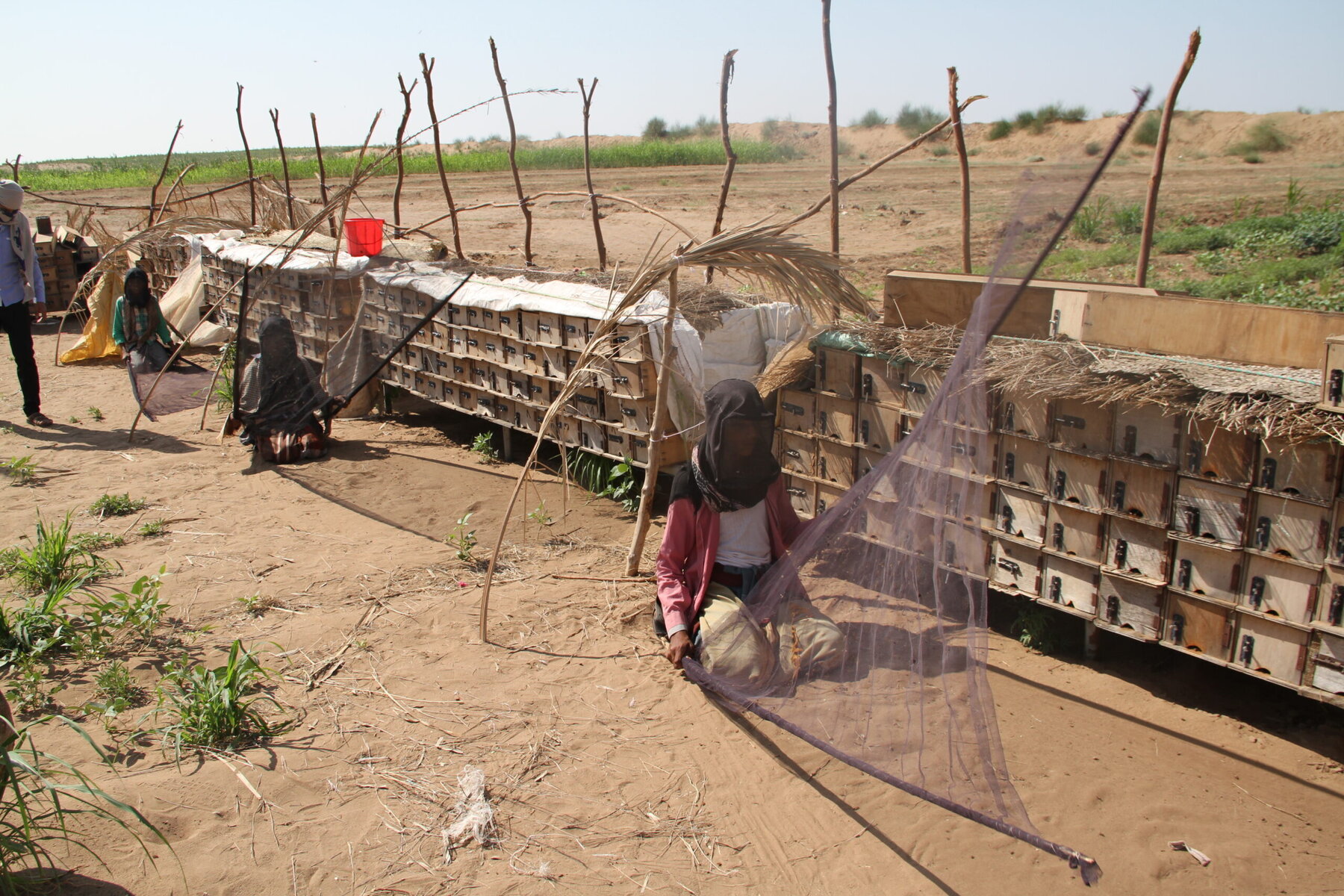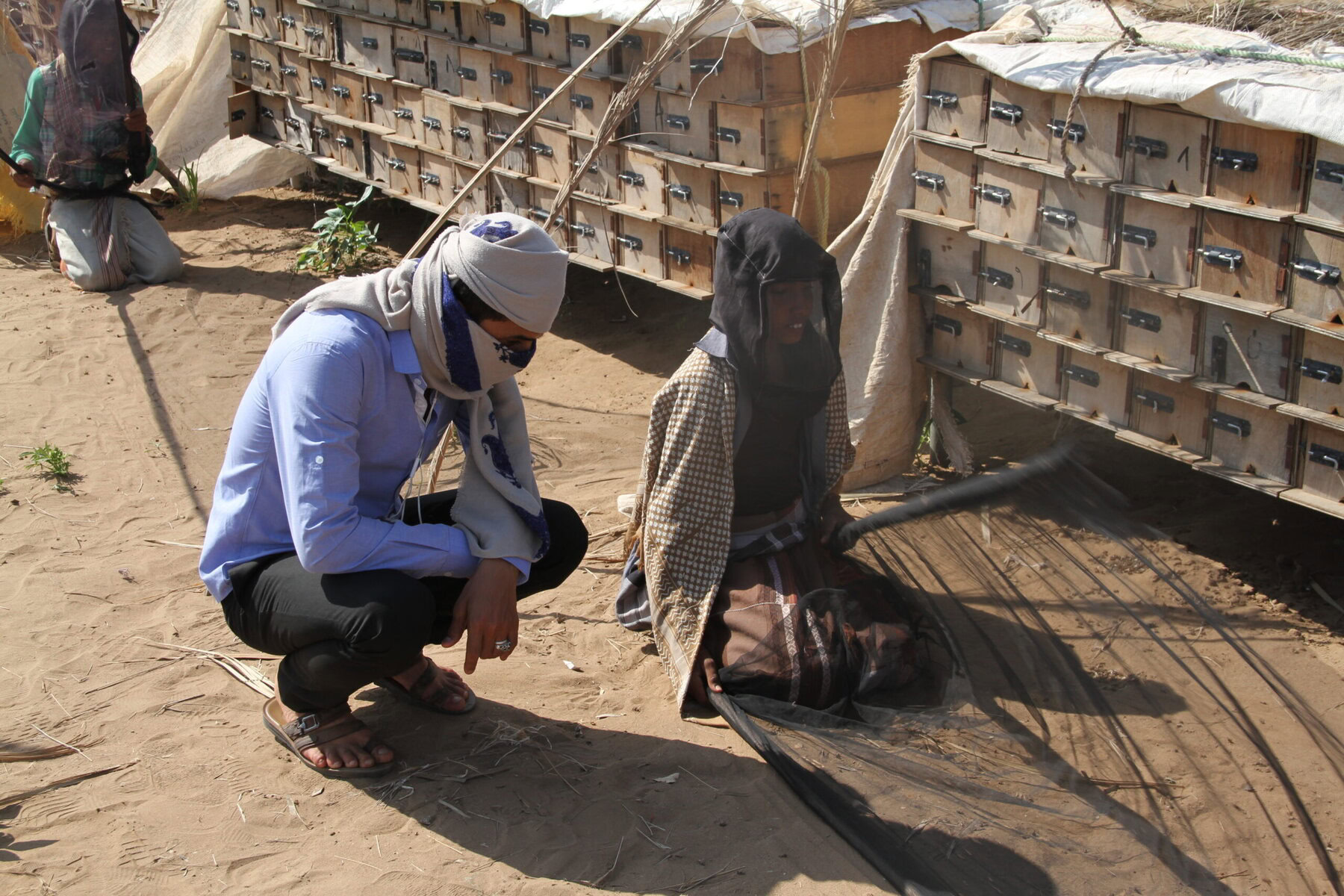How an Ancient Yemeni Tradition Is Reviving Bee Populations
As beekeeper Mosad Al-Humairi watched the truck carrying 48 of his beehives lurch to one side, its right wheels sinking dangerously in the muddy road and its top tilting towards a drop fewer than two meters away, his world came to a sharp halt. The 288-kilometer journey from Ibb in central Yemen to Al-Usaymat in the northern Amran province was meant to multiply his bees and boost their productivity. Instead, the continuous rainfall turned an unpaved stretch of road into a trap of muddy holes, pushing his livelihood to the edge of disaster.
“For what felt like an eternity, I stood frozen, fearing the loss of half my bees as my three sons scrambled to stabilize the truck,” he says of that fateful early September night.
Al-Humairi had already waited an extra week for the weather to clear so he could transport his beehives from the highlands of Ibb, where he had stayed since March, to Al-Usaymat, where the flowering season for the endemic Sidr tree had begun. These were a priceless seven days in the short lifespan of the prized Sidr flower, which blooms from mid-September to mid-November, and for which Yemeni honey is globally acclaimed. Not willing to lose more valuable time, he loaded his beehives onto two trucks and got on the road, braving the weather. The journey had to be made at night, to ensure that all the bees had returned to their hives for the day.

This age-old practice of seasonal migration, known as Tazeeb, is an integral part of the lives of Yemen’s people. With many being cattle herders, they are accustomed to the nomadic ways of navigating the country’s arid landscape in search of grazing land for their livestock. As climate change drives up temperatures and reduces rainfall in one of the world’s most water-scarce countries, Yemen’s beekeepers have recently adopted the nomadic practice in pursuit of blooming flowers to make the best of the country’s diverse and fragile ecosystems.
The impact Yemen’s mobile apiaries have had on bee numbers and productivity, according to experts and beekeepers, is remarkable. According to Yemen’s Ministry of Agriculture, the number of beehives surged by over 100,000 between 2017 and 2020 alone.
“I inherited 61 beehives from my father in 2010. For five years, good care of my bees brought their numbers up to 67 by 2015,” explains Al-Humairi. “That’s when I began Tazeeb. By 2024, they reached 97 beehives, thanks to the productive and healthy surroundings we keep the bees in throughout the year by chasing the blooming flowers.”

As the global bee population faces an alarming decline due to habitat loss, pesticides and climate change, Yemen’s Tazeeb-inspired migratory apiaries offer a natural method by which bee numbers can rapidly multiply.
“Prior to Tazeeb, my bees grew in number, but not at a pace that exceeded those that died during the cold and hot weathers, when forage is less,” Al-Humairi says.
The Sidr honey season
According to Abdulaziz Al-Junaid, director of livestock resources at Sanaa’s Ministry of Agriculture, an estimated 80 percent of Yemen’s 100,000 beekeepers move their hives seasonally, following the bloom cycles of various plants.
One of the most anticipated migrations guiding their schedule is the Sidr honey season. These large, thorny trees thrive in pockets across Yemen, producing flowers only during a brief period of time. Prized for its medicinal properties, Sidr honey can fetch up to $150 per kilogram.
“When the Sidr flowers start falling, signaling the onset of fruiting, most beekeepers move to areas dense with trees,” says beekeeper Mabrouk Al-Muntasir. This sees an influx of beekeepers arriving to Hadramaut in the east, Hajjah in the north, and scattered areas in Ibb, Dhamar and Taiz, in the period from September to November.
During the Sidr season, bees work intensively, as if aware of their brief window to produce honey, Al-Muntasir notes. “The bees exhaust themselves, so we move them to greener areas where they can recover and multiply,” Al-Muntasir says, explaining the eight-month period spent in grazing land. This migration results in varied honey types, as different plants influence the nectar supply.

Yemen’s Ministry of Agriculture, under the Houthi-led government in Sanaa, estimates that honey production has risen significantly in the last decade. In 2024 alone, Yemen produced 7,000 tons of honey, including Sidr, Samar and other varieties, up from 2,500 tons in 2017.
Climate and environmental threats
Yemeni beekeepers, like those around the world, face a growing list of threats. Multiple studies from around the world have shown the drastic impact pesticides have on bees’ ability to populate. In Yemen, some beekeepers have lost as much as a quarter their hives due to chemical spraying, Al-Junaid says. “Pesticide campaigns cause mass bee deaths,” he says, adding that conflicts have erupted between beekeepers and malaria control teams conducting pesticide sprays, with the most recent confrontation taking place in Ibb in April.
Al-Junaid also notes that the Ministry of Agriculture has urged the Ministry of Health to coordinate spraying schedules with Tazeeb routes, but enforcement remains inconsistent. “Some campaigns proceed without notice, leading to clashes,” he admits.

Another major concern is the illegal logging of Sidr trees. Due to Yemen’s economic crisis, exacerbated by nearly a decade of war, tree-cutting for firewood and charcoal has surged. “People have turned deforestation into a livelihood,” says Al-Junaid. “They don’t just cut dead trees anymore; they fell live ones, let them dry and turn them into charcoal.” Meetings with local authorities to curb deforestation have yielded little progress, and Sidr forests continue to shrink, he adds.
Climate change presents additional hurdles. Tazeeb was initially a response to shifting weather patterns, but worsening desertification, flooding and habitat loss have made migration even more critical, notes Al-Junaid. “Beekeepers from regions like Shabwa in the south and Tihama in the west have abandoned their original homes, spending the entire year migrating in search of forage,” he explains. According to Al-Junaid, Yemen now has an estimated 1.3 million beehives, up from 1.197 million three years ago. Tazeeb, he says, has been crucial to sustaining and expanding bee populations.
Bee researcher Abdulsalam Al-Samawi notes that winter forage shortages, deforestation and unregulated pesticide use remain the top challenges undermining the gains of Tazeeb. “Without coordination between farmers and beekeepers, the risks to bee populations will only grow,” he warns.
The struggles of a migratory beekeeper
Tazeeb is physically demanding, involving frequent travel and requiring at least two adults to attend to the beehives at all times. This is the daily reality for 20-year-old Montaser Al-Harazi, who spends his days closely monitoring the beehives.
“If just one hornet gets inside, it’s a disaster,” he explains. “Not only does it kill many bees, but it can cause the whole colony to flee.”
To protect the hives, he sets up traps for snakes and other predators and carries a handmade slingshot — a weapon he crafted from rubber and iron — to shoot any threats that approach. Over time, he has become a skilled hunter of creatures that prey on his bees.
But Tazeeb comes at a cost. “I live like the bees now, always moving, never settling,” Al-Harazi reflects. “Just as climate and the environment have taken away the bees’ stability, war and the struggle to survive have taken away ours.”

댓글
댓글 쓰기